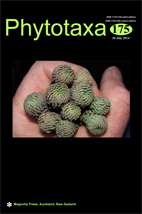Abstract
Two Brassicaceae novelties are reported from Iran. Erysimum hezarense (Erysimeae) is described and illustrated as a newly discovered species. It resembles E. subulatum, E. laxiflorum and E. iraqense but can be readily distinguished by the indumentum of stem, leaves and pedicels; bicolor petals; and number of flowers on the main inflorescence. It is also separated geographically being restricted to Hezar mts. (prov. Kerman, South Iran) where none of the related species occurs. Because of the very limited distribution and high risk of its habit destruction, inclusion of E. hezarense into IUCN Red List with a status vulnerable (VU) is proposed. Besides, Rhammatophyllum gaudanense (Euclidieae) is reported from NE Iran representing the first record of the genus for the country. Contrary, the previous record of R. gaudanense from Afghanistan is considered doubtful and not confirmed. Detailed morphological description, illustration and synonymy of R. gaudanense is provided along with the key differences from the closely related taxa. Distribution maps for both E. hezarense and R. gaudanense are given.

